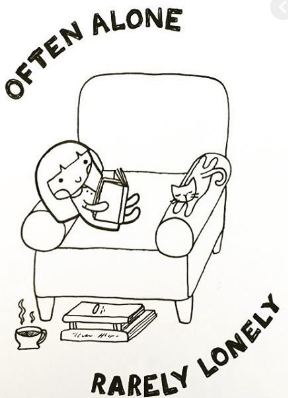Introversion is a personality trait characterized by a focus on internal feelings rather than on external sources of stimulation. Introverts and extroverts are often viewed in terms of two extreme opposites, but the truth is that most people lie somewhere in the middle. Being an introvert can be difficult if you let it.

While introverts make up an estimated 25 to 40 percent of the population, there are still many misconceptions about this personality type. It is also important to note that introversion is not the same thing as social anxiety or shyness. Being an introvert does not mean that you are socially anxious or shy.
What is an introvert
Introversion is one of the major personality traits identified in many theories of personality.
People who are introverted tend to be inward turning, or focused more on internal thoughts, feelings and moods rather than seeking out external stimulation.
Introversion is generally viewed as existing as part of a continuum along with extroversion. Introversion indicates one end of the scale, while extroversion represents the other end.
The terms introversion and extroversion (also often spelled extraversion) were popularized through the work of Carl Jung and later became central parts of other prominent theories including the big 5 theory of personality.
The introversion-extroversion dimension is also one of the four areas identified by the Myers-Briggs Type Indicator (MBTI). According to many theories of personality, everyone has some degree of both introversion and extroversion. However, people often tend to lean one way or the other.
Introverts tend to be more quiet, reserved, and introspective. Unlike extroverts who gain energy from social interaction, introverts have to expend energy in social situations. After attending a party or spending time in a large group of people, introverts often feel a need to “recharge” by spending a period of time alone.1
.
Causes
In order to know why some people are introverted and some people are extroverted, it is important to understand the role that your body’s physiology plays. The way that your body responds to the outside environment plays a critical role in determining your level of extroversion and introversion.
The psychologist Hans Eysenck suggested that these arousal levels could be thought of as a continuum. According to his arousal theory of extroversion:
- 15 percent of people have a minimal set point, meaning they naturally have low arousal levels
- 15 percent of people have a high setpoint, meaning they naturally tend to be more aroused
- 70 percent of people lie somewhere in the middle of the continuum
According to Eysenck’s theory, introverts are those that have naturally high levels of arousal. Because introverts tend to experience chronically high arousal levels, they tend to seek activities and environments where they can escape from overstimulation.
Because of their naturally high arousal levels, they are more alert and take in more information from the environment.
Common Signs
Do you assume that you know who is an introvert and who isn’t? While you might think of an introvert as a shy wallflower who prefers to stay home alone instead of socializing, introverts can actually come in many types with a wide variety of characteristics.

There are certainly plenty of introverts who are socially reserved and who would prefer to stay home and read a book rather than go to a big party, but there are also plenty of introverts who enjoy socializing.
You might even be surprised to learn that many people who you think of as “social butterflies” might actually be quite introverted.
The following are just a few of the causes of being an Introvert and what action you can take to break the trait. .
Being Around Lots of People
Do you ever feel exhausted and drained of energy after spending time with a lot of people? After a day interacting with others, do you often need to retreat to a quiet place and have an extended amount of time all to yourself?
One of the major characteristics of this personality type is that introverts have to expend energy in social situations, unlike extroverts who gain energy from such interactions.
That doesn’t mean that all introverts avoid social events altogether.
Many introverts actually enjoy spending time around others, with one key caveat—introverts tend to prefer the company of close friends. While an extrovert might go to a party with the goal to meet new people, an introvert intends to spend quality time talking to good friends.
You Enjoy Solitude
As an introvert, your idea of a good time is a quiet afternoon to yourself to enjoy your hobbies and interests.

A few hours alone with a good book, a peaceful nature walk or your favorite television program are great ways to help you feel recharged and energized.
This does not mean that the average introvert wants to be alone all the time. Many introverts love spending time with friends and interacting with familiar people in social situations. The key thing to remember is that after a long day of social activity, an introvert will probably want to retreat to a quiet place to think, reflect, and recharge.
If having a few hours to be alone sounds like your idea of a good time, you just might be an introvert.
You Have a Small Group of Close Friends
One common misconception about introverts is that they don’t like people. While introverts typically do not enjoy a great deal of socializing, they do enjoy having a small group of friends to whom they are particularly close.
Instead of having a large social circle of people they know only on a superficial level, introverts prefer to stick to deep, long-lasting relationships marked by a great deal of closeness and intimacy.
Researchers have found that people high in this trait tend to have a smaller group of friends. While extroverts generally have a wide circle of friends and acquaintances, introverts typically choose their friends much more carefully.
Their closest relationships tend to be profound and significant. They also prefer to interact with people on a one-on-one basis rather than in a large group setting.
If your social circle tends to be small but very close, there’s a pretty good chance you are an introvert.
People Often Describe You as Quiet and Difficult to Get to Know
Introverts are often described as quiet, reserved, mellow and are sometimes mistaken for being shy.
While some introverts certainly are shy, people certainly should not mistake an introvert’s reserve for timidity. In many cases, people with this personality type simply prefer to choose their words carefully and not waste time or energy on needless chit-chat.
If you are the quiet type and a bit reserved, you probably are an introvert.
Too Much Stimulation Leaves You Distracted and Unfocused
When introverts have to spend time in activities or environments that are very hectic, they can end up feeling unfocused and overwhelmed. Extroverts, on the other hand, tend to thrive in situations where there is a lot of activity and few chances of becoming bored.

According to at least one study, researchers have found that introverts tend to be more easily distracted than extroverts, which is part of the reason why introverts tend to prefer a quieter, less harried setting.
If you tend to feel overwhelmed in busy social situations, you probably tend to be an introvert.
You Are Very Self-Aware
Because introverts tend to be inward-turning, they also spend a great deal of time examining their own internal experiences. If you feel like you have a very good knowledge and insight into yourself, your motivations, and your feelings, you might be more of an introvert.
Introverts tend to enjoy simply thinking about and examining things in their own minds. Self-awareness and self-understanding is important to introverts, so they often devote a great deal of time to learning more about themselves. This might involve exploring hobbies they enjoy, thinking about their lives, and reading books that explore themes and topics that are important to them.
If you feel that you are self-aware and enjoy gaining deep knowledge about yourself, then you might be more of an introvert.
You Like to Learn by Closely Observing
Where extroverts tend to prefer to jump right in and learn through hands-on experience, introverts typically prefer learning through observation. While extroverts typically learn through trial and error, introverts learn best by watching.
Introverts like to watch others perform a task, often repeatedly, until they feel that they can replicate the actions on their own. When introverts do learn from personal experience, they prefer to practice somewhere private where they can build their skills and abilities without having to perform for an audience.
If you like to learn more by watching rather than doing, there is a chance that you have a more introverted personality.
You Are Drawn to Jobs That Involve Independence
As you might imagine, jobs that require a great deal of social interaction usually hold little appeal to people high in introversion. On the other hand, careers that involve working independently are often a great choice for introverts.
For example, an introvert might enjoy working as a writer, accountant, computer programmer, graphic designer, pharmacist, or artist.
Introversion vs. Shyness
It is important to note that introversion does not necessarily equate with shyness. In their book, The Development of Shyness and Social Withdrawal, authors Schmidt and Buss write, “Sociability refers to the motive, strong or weak, of wanting to be with others, whereas shyness refers to behavior when with others, inhibited or uninhibited, as well as feelings of tension and discomfort.”
Shyness indicates a fear of people or social situations. Introverts, on the other hand, simply do not like to spend lots of time interacting with other people.
However, introverts do appreciate being around people to whom they are close. They find engaging in “small talk” tedious but do enjoy having deep, meaningful conversations. Introverts also tend to think about things before talking. They want to have a full understanding of a concept before they voice an opinion or try to offer an explanation.
Understanding the Dimensions of Introversion and Shyness
Misconceptions
In an excellent article in Atlantic Monthly, author Jonathan Rauch took on some of the common myths and misconceptions about introverts. While introverts are often labeled as shy, aloof, and arrogant, Rauch explains that these perceptions result from the failure of extroverts to understand how introverts function.
“Extroverts have little or no grasp of introversion,” Rauch suggests. “They assume that company, especially their own, is always welcome. They cannot imagine why someone would need to be alone; indeed, they often take umbrage at the suggestion. As often as I have tried to explain the matter to extroverts, I have never sensed that any of them really understood.”
The bottom line
Attitude is the most important choice any of us will make. We made it yesterday and we get another choice to make it today. And then again tomorrow. The choice to participate. To be optimistic. To intentionally bring out the best in other people.
We make the choice to inquire, to be curious, to challenge the status quo. To give people the benefit of the doubt. To find hope instead of fear in the face of uncertainty. Of course, these are attitudes. What else could they be? And of course, they are a choice. No one does these things to us. We choose them and do the work (and find the benefits) that come with them.
